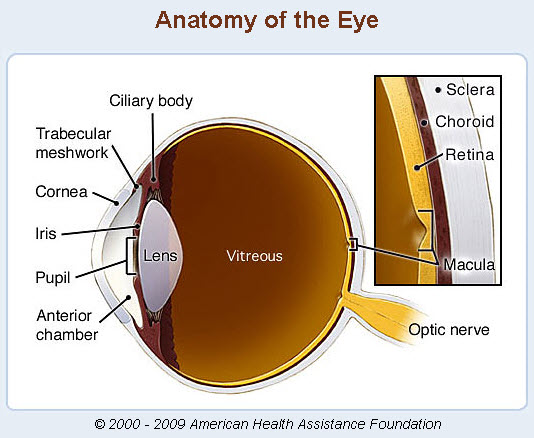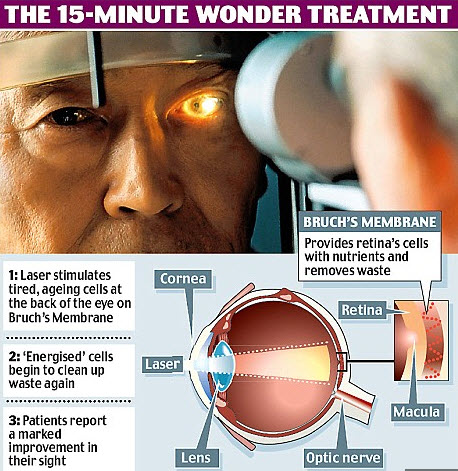Have you ever heard of age-related macular degeneration, or AMD? Do you suffer from AMD? It is a common form of blindness, and as you get older (hence the age related part), your macula starts to degenerate (hence the degeneration part) and you lose your detail vision. This sucks, as there hasn’t been much that people can do about it happening until lately. It’s not a cure per se, but it’s a new technique that doctors are saying might be able to help re-generate part of the macula that needs a bit of wakey-wakey-eggs-and-bakey.
By stimulating a part of the eye called the Bruch’s Membrane, scientists in the UK have been able to slow down degeneration of the macula, and in some cases stop it altogether. Using a laser to “breathe some life” into the membrane, scientists have been able to wake it up a bit so that it continues to perform its function and not just sit there like a dunce. The laser treatment takes about ten to fifteen minutes. Crazy, huh?
Oh yeah – “hey Jim, what is the Bruch’s Membrane, and what does it do?”
Bruch’s Membrane is a part of the eye behind the retina, between the retina. Bruch’s Membrane performs a very, very important function – it removes waste products from the retina and brings in nutrients and oxygen. You’d think that’s pretty important, huh? Check out an eye diagram:

Bruch’s Membrane is part of the Choroid, which lives behind the retina. When it doesn’t do its job, waste products just build up around the macula and the cells begin to die over time. The laser treatment targets this membrane to hopefully stimulate it so it starts to perform its waste removal function:

From the article I read about this procedure in the Daily Mail:
The technique is the brainchild of Professor John Marshall, an ophthalmologist at King’s College London who pioneered laser surgery to correct shortsightedness.
Professor Marshall, who hopes the treatment could be available in a couple of years, said: ‘It is really exciting news. It won’t bring back damaged eyesight but it may prevent AMD.’
The technique rejuvenates the ‘Bruch’s membrane’ – a thin layer that lies behind the retina.
This provides the retina’s light-sensitive cells with nutrients and removes waste created as a by-product of the way retina cells renew themselves.
But the membrane’s cells eventually lose the ability to take waste away, allowing deposits to build up.
It can then become so damaged that the retina’s lightsensitive cells start to die off. In a trial involving more than 100 diabetics, Professor Marshall found that using a laser stimulated the membrane’s tired, ageing cells into action.
After the cells were ‘ energised’ by the laser, they began to clean up the waste again.
Patients also said the treatment led to a ‘ marked improvement’ in their sight.
The non-invasive operation uses a laser modified to give pulses of light that do not damage the eye’s light-sensitive cells or cause any dangerous heating of the target area.
Professor Marshall will now treat up to 200 people with AMD in one eye as part of a second trial. Such patients usually get the disease in the other eye within three years.
He wants to see if the laser prevents the good eye losing its sight. ‘If you can delay the onset by three, four, six, seven or ten years, it’s proof of the principle,’ he said.
Tom Pey, of Guide Dogs for the Blind, which funded the research, said: ‘This is potentially a huge breakthrough for millions. The science behind it is proven.’
The Macular Disease Society said: ‘If this works, then it’s very exciting. However, it will be years before this could be ready for use.’
Let’s hope we read more about this in the very near future!





my mother (retired nurse)is so frustrated that she has amd and there seems to be NO HELP this is ruining her so called retirement,she cannot see differences in mney,cant use a telephone read or even control the tv .she has magnifying glasses which she terms as useless.
i know nurses dont make the best patients BUT she still has a brain and is willing to try anything that would help her see and cost is not an issue.
Comments are closed.